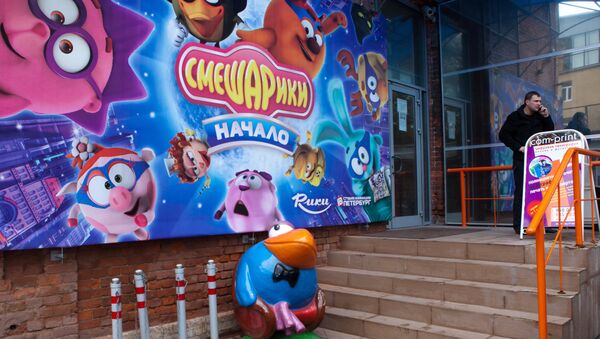Smeshariki (2004)
On American TV, Smeshariki is broadcast under the name Kikoriki. Back in 2008, 99 episodes were adapted for the US audience. The cartoon is shown in 60 countries and has been translated into 15 languages.
The US studio, which purchased the distribution rights, will broadcast the cartoons on television and the Internet.
"We love the world of Kikoriki," Vice-President of Acquisitions at Shout! Factory Jordan Fields said in a statement on Monday. "Legend of the Golden Dragon and Team Invincible are two highly entertaining comedies with truly nutty characters, clever storytelling, gentle satire and rich animation."
Cheburashka (1966)
Besides Russia, Cheburashka dolls are also produced in Japan and China. United States National Champion figure skater Johnny Weir is known to be an avid collector of Russian Cheburashka memorabilia.
Luntik (2006)
The Adventures of Luntik and His Friends, or simply Luntik, is broadcasted in Finland, Hungary, Serbia and Thailand. Abroad, these educational animated series for preschoolers are better known as Moonzy. The show stars a small furry alien named Luntik, who hatched on the moon and fell to Earth, where he learns about the world through new experiences and interactions with other creatures.
Well, Just You Wait! (1969)
Although this cartoon known in Russia as Nu, Pogodi! was accused of copying the popular American TV series Tom and Jerry, this does not prevent it from being popular in other countries. In 2010, the Mint of Niue, an island country northeast of New Zealand, issued a memorial silver coin with images of the Wolf and the Hare — the main characters of the series.
Masha and the Bear (2009)
Last year, the computer-animated series became the most popular cartoon in Italy, and the episode "Masha + the Porridge" gathered more than a billion views on YouTube, making it the most watched animated series online!
Hedgehog in the Fog (1975)
Famous Japanese film director Hayao Miyazaki, who created such anime masterpieces as My Neighbor Totoro, Spirited Away and Howl's Moving Castle, named this Soviet story about a little hedgehog his favorite work.
The Snow Queen (1957)
The Snow Queen is considered the most popular Soviet animated film abroad. In the 1970s, it was traditionally shown on US television on New Year's Eve.
Hayao Miyazaki stated that this film is one of his inspirations to work in animation. When he started his career, Miyazaki had a rough start and was thinking of leaving animation. The Snow Queen reignited his love of animation and he decided to continue working in anime.



